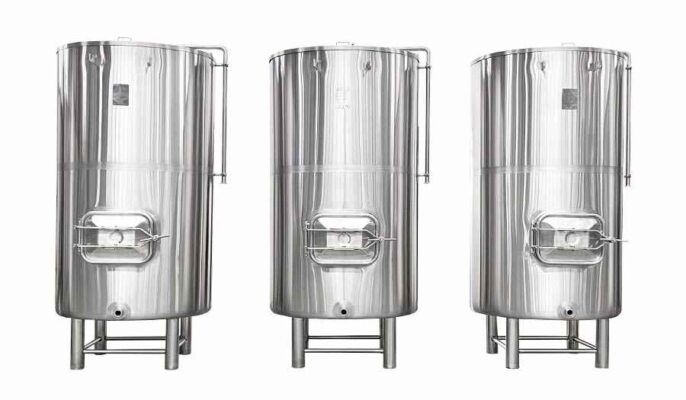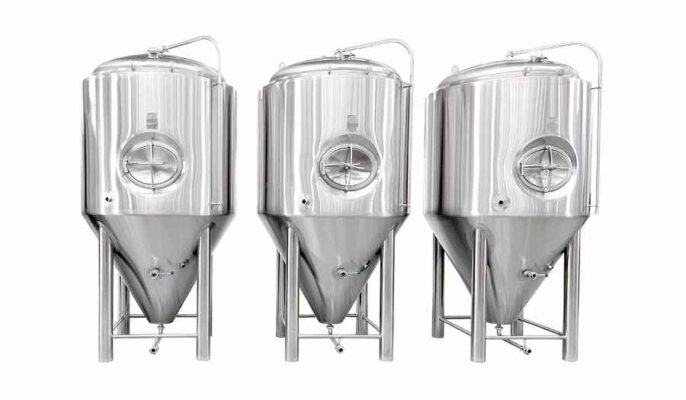Even the smallest details can have a huge impact on the brewing process. Every small change you make to the brewing process can create a butterfly effect somewhere along the line and completely change the product. Be very careful in making decisions of process and equipment. The sensitive nature of the brewing process is why its equipment is so important and needs to be taken . For fermentation, aging or maturation, Brite tanks and Unitanks are both good choices. There are a few factors to consider. In this article, you’ll learn the differences between Brite tanks and Unitanks so you can make a more informed decision.
What is Bright Tank?
Between the Bright Tank and the Unitanks, it could be argued that the Bright Tank has a simpler design. the biggest and most immediate difference between the British tank and the Unitank is their shape. The Bright Tank has a very simple, flat-bottomed cylindrical design. Flat bottoms are not as good for the fermentation process as the conical bottoms of monocoques, but beer cans are still great for storing mature beer or holding beer while it awaits packaging.

What is Unitank?
As we have already mentioned, the main difference between a Unitank and a Brite Tank is the shape of the bottom. Unit tanks are also cylindrical tanks, but have a conical bottom instead of a flat bottom. The conical shape allows yeast to accumulate in an area at the bottom. This feature makes unitanks an excellent choice for fermentation and aging tanks, as you can filter out the yeast after fermentation is complete.
Advantages of Brite Tank
Fermenting in a yeast container is possible, but the format will make removing the yeast troublesome. As such, they are generally used only for aging and fermentation, and as a space to hold the beer before packaging or sale.
Beer production increases
For breweries that produce large quantities of beer, beer cans may be the best choice. larger breweries ferment beer in one area and serve or pack it in another. By using a brite tank, you can transfer fermented beer out of the fermenter it occupies, thereby freeing up that fermenter to receive and start another batch of beer when you serve or package from the brite tank. This means more batches can be produced in less time.
Improve beer clarity
The Brite tank is usually the destination for the beer after it has been fermented for a period of time in a separate tank. Because the yeast is filtered out before being transferred to beer tanks for aging, your final product will be much clearer than a beer aged with leftover yeast. Some breweries prefer this clearer quality.
Substitutes are cheaper
Replace the tanks used for fermentation and aging if necessary. When this happens, Brite tanks tend to be cheaper because they have a simpler design and only serve one function. Replacing Union tanks cost more than replacing British tanks.
Advantages of Unitank
The advantage of using Unitank is actually its versatility. It can be used for many parts of the brewing process, so it can reduce the cost of separate equipment from the middleman that some consider unnecessary.
A simpler brewing process
The ability to combine ripening and fermentation processes improves development by eliminating one process. Space is saved as two separate water tanks are not required. This also means the beer doesn’t have to be moved around as much as it has to be transferred to a separate tank, saving time and effort.
Lower risk of contamination
One of the most critical things to consider when brewing is the risk of contamination that may be caused by outside organisms or the air itself. Every time beer is removed from the container, it is exposed to the open air, creating liquefied oxygen. While these microorganisms are not usually lethal, they can cause your beer to taste bad, which is the last thing you want.

How to choose between tanks?
When to choose Unitank?
Unitanks are perfect for small breweries or brewpubs. For these facilities, space is often limited, breweries produce fewer kegs of beer, and the focus is less on packaging and more on serving beer straight away. Combined cans work well in these situations because they save space and labor without compromising the productivity of individual packaging teams.
When to Choose Brite Beer Cans?
Brite cans are better suited for large-scale production, especially those that rely on packaging and shipping the majority of their product. Brite tanks allow you to open more fermenters at once. And because beer cans can hold more liquid at a time, they can produce larger beer yields. If you’ve stretched your limits and are brewing more kegs of beer than a microbrewery, it might be a good idea to look at British beer tanks.




